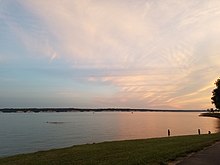Lewis and Clark Lake
| Lewis and Clark Lake | |
|---|---|
msl | |
| Settlements | Yankton, SD Springfield, SD Running Water, SD Santee, NE Niobrara, NE |
| 1 Shore length is not a well-defined measure. | |
Lewis and Clark Lake is a 31,400
History
The Missouri River Valley Area is abound with history involving several early Native American Tribes, Pioneers, and other settlers to the area due to ease of river transportation and abundant resources.[3] Lewis and Clark Lake is named after explorers Meriwether Lewis and William Clark of the Lewis and Clark Expedition. The lake is located along the Lewis and Clark National Historic Trail.[4]
The
In 1874, the
Location
The lake is an
Lewis and Clark Visitor Center
The Lewis and Clark Visitor Center is located just south of Gavins Point Dam atop
Parks and recreation



Lewis and Clark Lake is a very popular regional tourist destination in the upper
Located downstream of the lake is the 59-mile reach of the Missouri National Recreational River (MNRR) which stretches eastward from the dam to Ponca State Park, upstream of the lake is the 39-mile reach of the MNRR which stretches westward to Fort Randall Dam.
List of recreation and public use areas
The following are public parks and lake access areas on Lewis and Clark Lake:[11]
- Nebraska:
- Lewis and Clark State Recreation Area (NE GPC)
- Weigand-Burbach Area & Marina
- South Shore Recreation Area
- Bloomfield Recreation Area
- Miller Creek Recreation Area
- Niobrara State Park (NE GPC)
- Niobrara Recreation Area (Village of Niobrara)
- USACE)
- Hideaway Acres (Hideaway Acres Assn.)
- Santee Recreation Area (USACE & Santee Sioux Nation)
- Cottonwood Recreation Area (USACE)
- Nebraska Tailwaters Recreation Area (USACE)
- Training Dike Recreation Area (USACE)
- Deep Water Area (USACE)
- Devil's Nest (USACE)
- Bazile Creek Wildlife Management Area (NE GPC)
- Lewis and Clark State Recreation Area (NE GPC)
- South Dakota:
- Lewis & Clark Recreation Area (SD GFP)
- Lewis & Clark Marina and Resort
- Pierson Ranch Recreation Area
- Chief White Crane Recreation Area
- Gavins Point National Fish Hatchery and Aquarium (U.S. Fish & Wildlife Service)
- Tabor Lakeside Use Area (SD GFP)
- Charley Creek Lakeside Use Area (SD GFP)
- Twin Bridges Lakeside Use Area (SD GFP)
- Sand Creek Lakeside Use Area (SD GFP)
- Springfield Recreation Area (SD GFP)
- Springfield Bottoms Game Production Area (SD GFP)
- Running Water Lakeside Use Area (SD GFP)
- Lewis & Clark Recreation Area (SD GFP)
- Key:
- NE GPC = Nebraska Game and Parks Commission
- USACE = U.S. Army Corps of Engineers
- SD GFP = South Dakota Department of Game, Fish and Parks
Fish, wildlife and natural resources
The
Species of
The U.S. Army Corps of Engineers and the
Current lake issues

There are several issues impacting recreation, wildlife, and other issues. In 2014
Lewis and Clark Lake is significantly impacted by
See also
- Gavins Point Dam
- Lake Yankton
- Missouri National Recreational River
- Santee Sioux Reservation
- List of dams and reservoirs in South Dakota
- List of dams and reservoirs in Nebraska
- List of dams and reservoirs in United States
Further reading
External links
- U.S. Army Corps of Engineers, Gavins Point Project & Lewis and Clark Lake (Official site)
- Corps Lakes - Lewis and Clark Lake
- Recreation.gov - Lewis and Clark Lake
- Lewis and Clark State Recreation Area - Nebraska Game and Parks Commission
- Lewis and Clark Recreation Area - South Dakota Department of Game, Fish & Parks
- Springfield Recreation Area - South Dakota Department of Game, Fish & Parks
References
- ^ "Gavins Point Dam & Power Plant". United States Army Corps of Engineers. Archived from the original on 2011-06-01. Retrieved 2010-04-26.
- ^ "Missouri River Dams & Lakes".
- ^ "Cultural Resources".
- ^ "Lewis & Clark National Historic Trail (U.S. National Park Service)".
- ^ "Omaha District > Missions > Dam and Lake Projects > Missouri River Dams > Gavins Point".
- ^ "Lewis & Clark National Historic Trail (U.S. National Park Service)".
- ^ "Omaha District > Missions > Dam and Lake Projects > Missouri River Dams > Gavins Point".
- ^ "Lewis & Clark Recreation Area - SD State Parks". Archived from the original on 2020-09-21. Retrieved 2019-01-26.
- ^ "Omaha District > Missions > Dam and Lake Projects > Missouri River Dams > Gavins Point".
- ^ "Corps Lakes Gateway: South Dakota - Lewis and Clark Lake".
- ^ File:LewisClarkLakeMap.png
- ^ "Omaha District > Missions > Dam and Lake Projects > Missouri River Dams > Gavins Point".
- ^ https://outdoornebraska.gov/wp-content/uploads/2015/10/2015FishSamplingReport_LewisAndClarkReservoir.pdf [bare URL PDF]
- ^ "MRRP - Missouri River Recovery Program". Archived from the original on 2016-11-23. Retrieved 2018-04-14.
- ^ "Gavins Point National Fish Hatchery".
- ^ "Zebra Mussels discovered at Lewis and Clark Lake".
- ^ http://msaconline.com/
